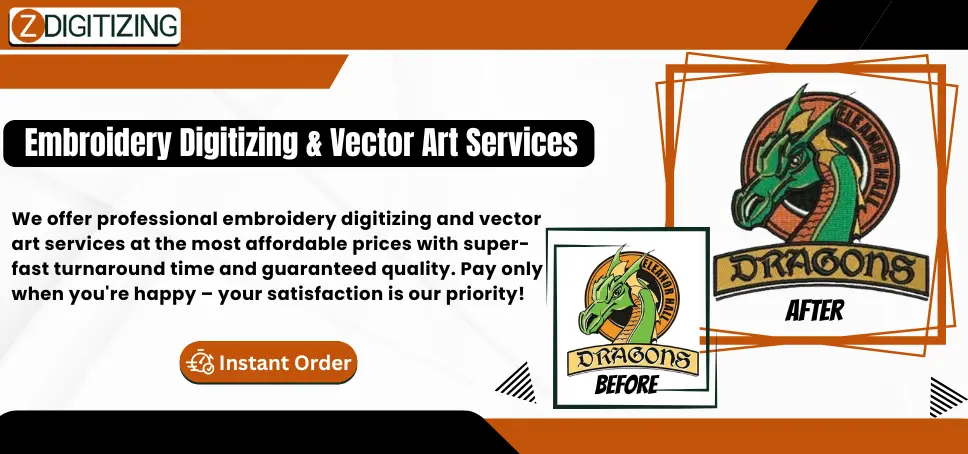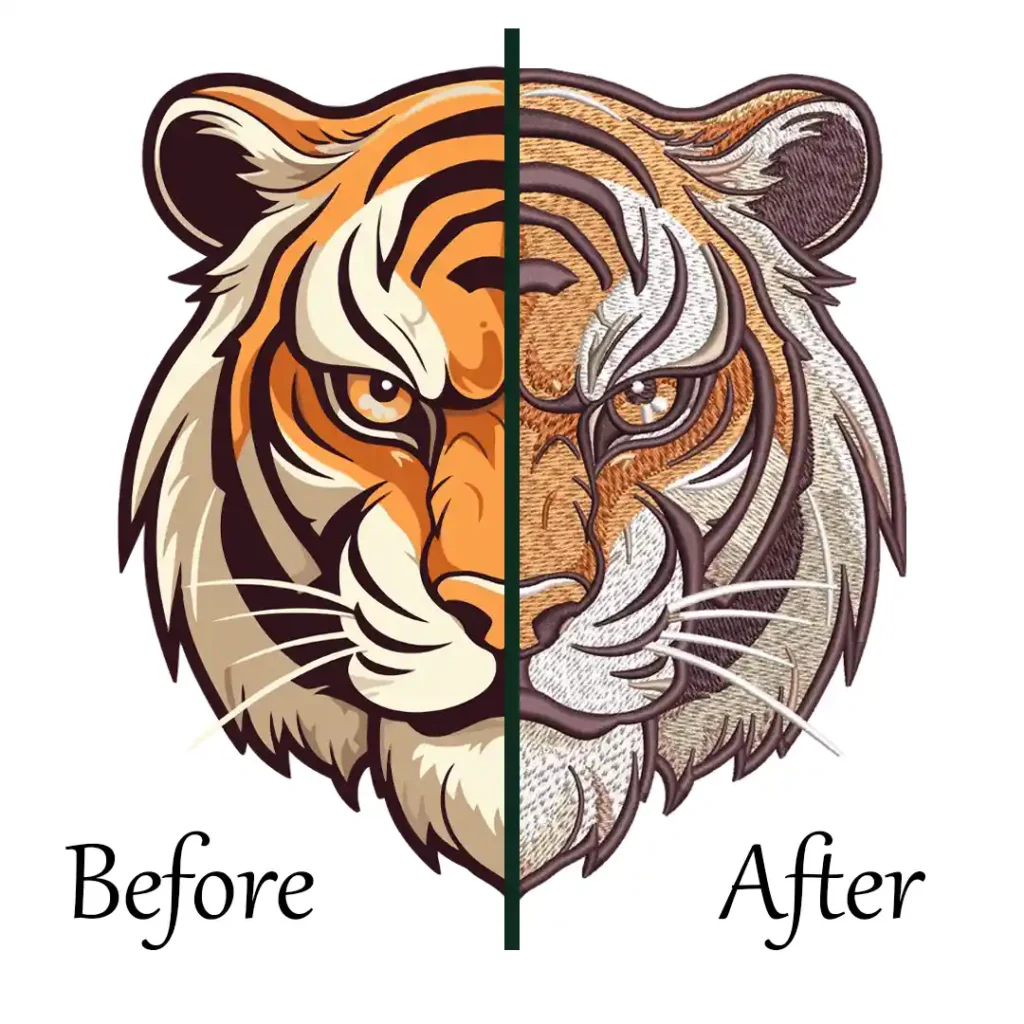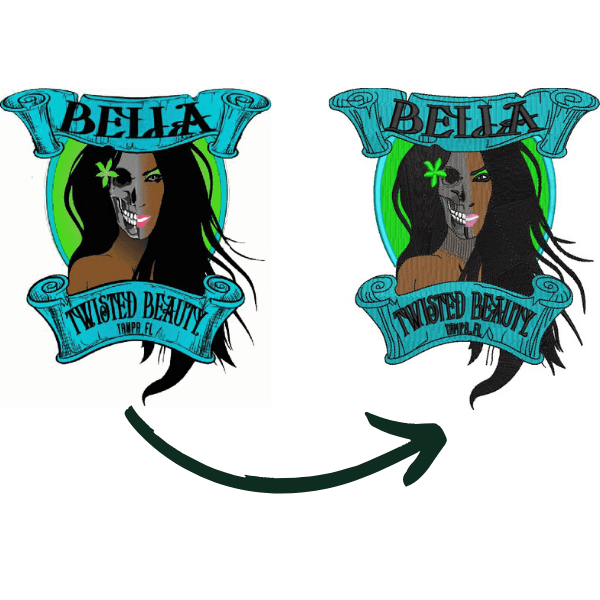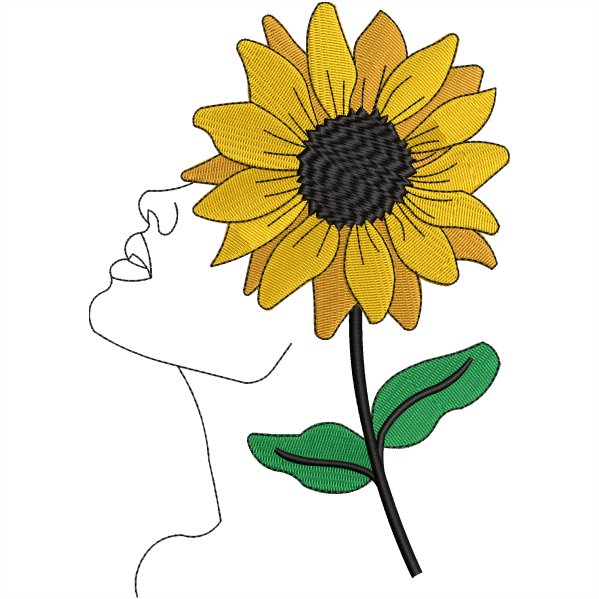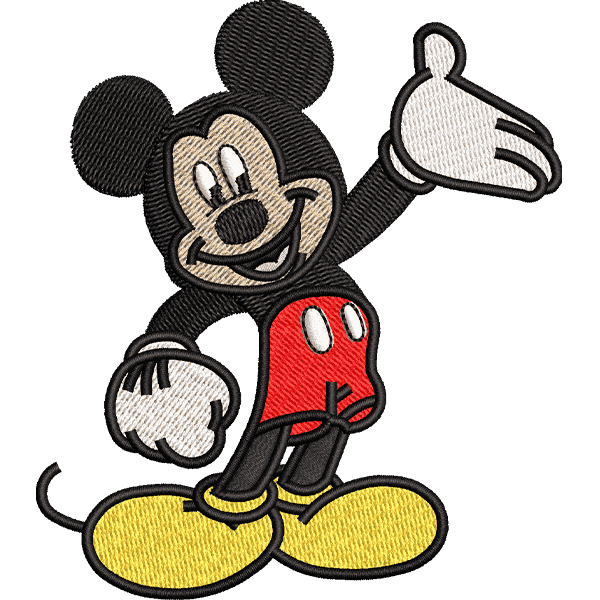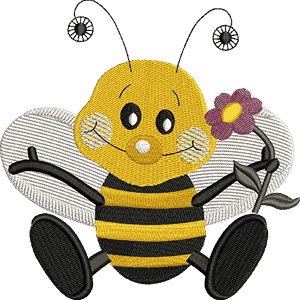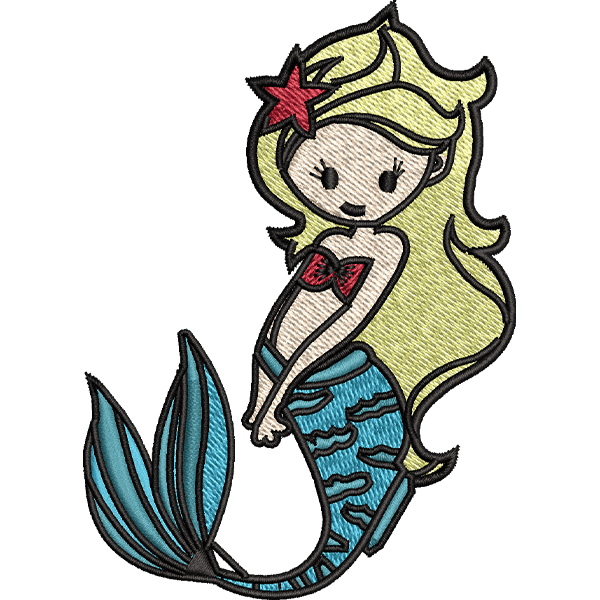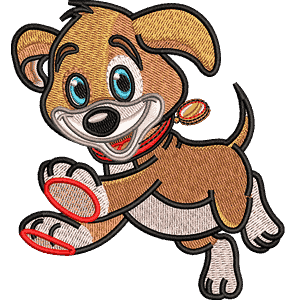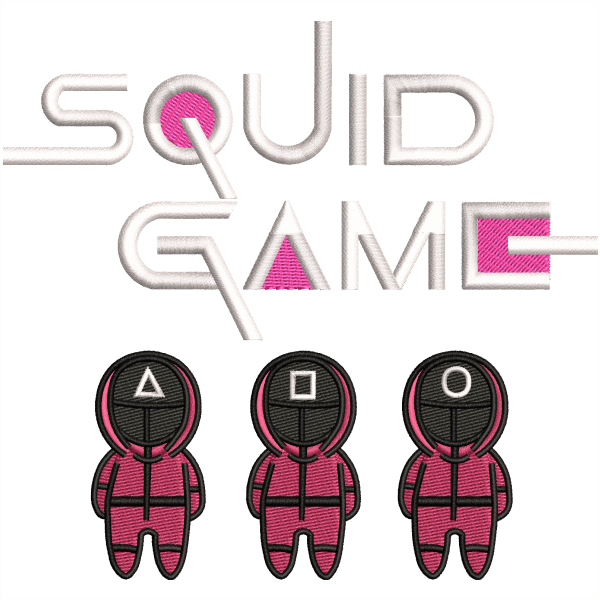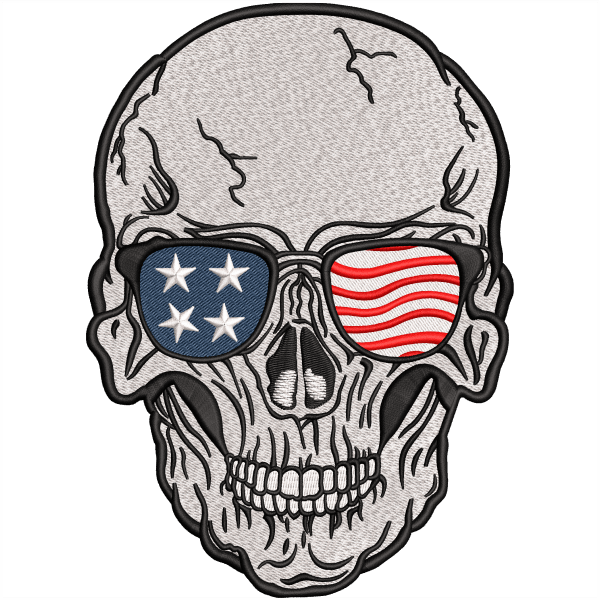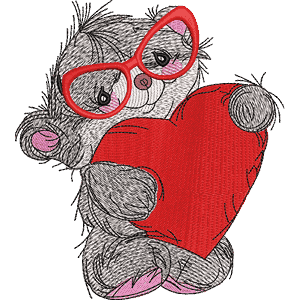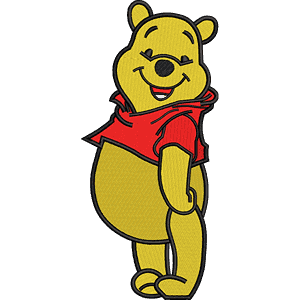What fabric to use for embroidery is a common question, especially for those starting with machine embroidery. Ever had your stitches sink into stretchy fabric or your design end up crooked? You’re not alone! The truth is, not every fabric works well for machine embroidery. In this article, we’ll walk you through the 7 best fabrics that are proven to give smooth, stable, and professional-looking results.
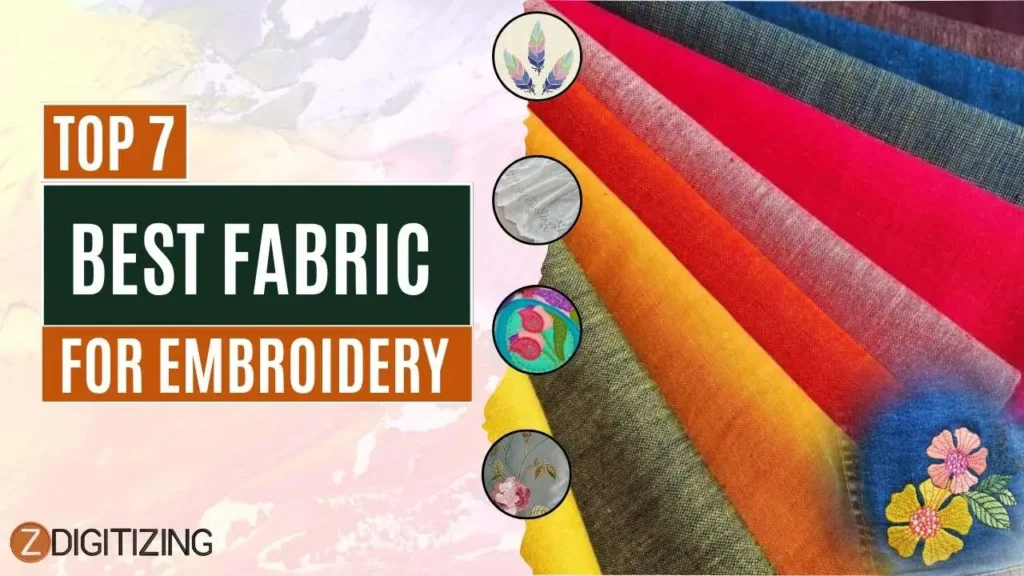
Whether you’re stitching on shirts, bags, or home décor, you’ll learn exactly which materials to choose, and why they matter, so your next project turns out just the way you imagined.
What Fabric to Use for Embroidery: 7 Best Options
Top 7 Fabrics for Machine Embroidery (Tested & Trusted)
Choosing the right fabric can dramatically improve your results in machine embroidery. The right material not only holds stitches better but also reduces problems like puckering and misalignment, especially when working with machine embroidery fabrics.
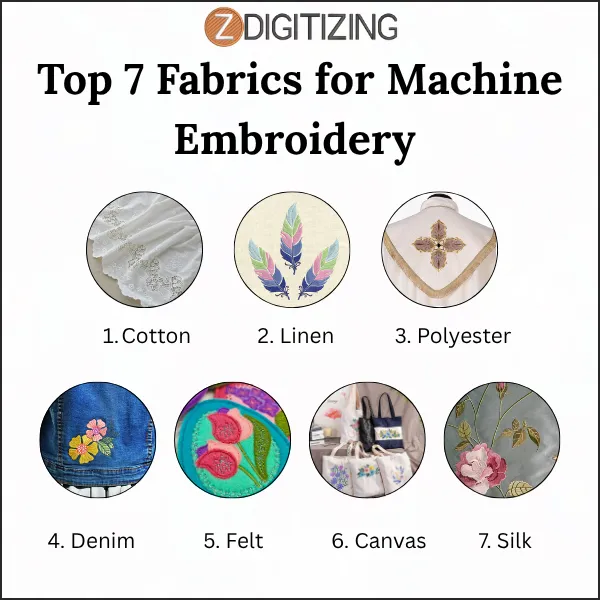
Here are the 7 best embroidery fabric types:
- Cotton
- Linen
- Polyester
- Denim
- Felt
- Canvas
- Silk
Let’s explore each fabric in detail to help you choose the best one for your next embroidery project.
1. Cotton
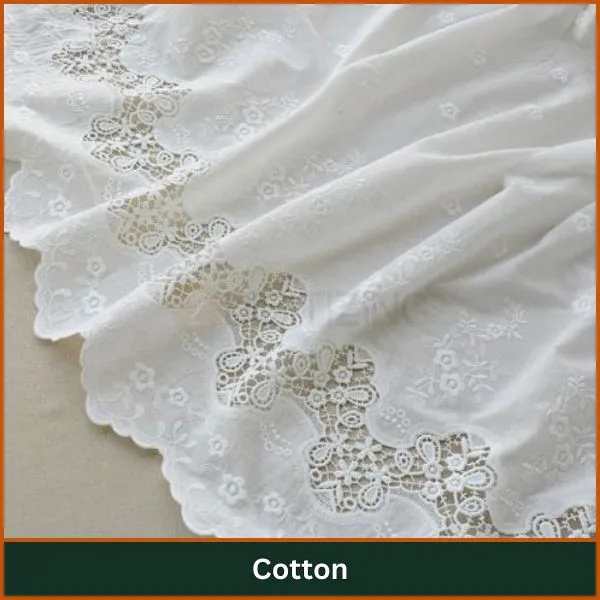
Cotton is one of the most reliable and beginner-friendly fabrics for machine embroidery. It’s a natural fiber with a tight, even weave that handles machine stitching very well. Whether you’re working on napkins, T-shirts, or quilt blocks, cotton provides a stable surface for clean designs.
It pairs easily with both light and medium-density embroidery. Using a tear-away or cut-away stabilizer gives you better results and reduces puckering. Cotton also absorbs color well, so your thread stands out nicely.
Pre-washing is essential to prevent shrinking after embroidery. This fabric is widely available in many weights and colors.
Best for: Everyday designs, text, monograms, floral patterns, quilt squares.
Pricing: Cotton is affordable and easy to find in fabric stores and online. Prices typically range from $5 to $12 per yard, depending on quality and brand.
Pros and Cons
Pros | Cons |
|
|
2. Linen
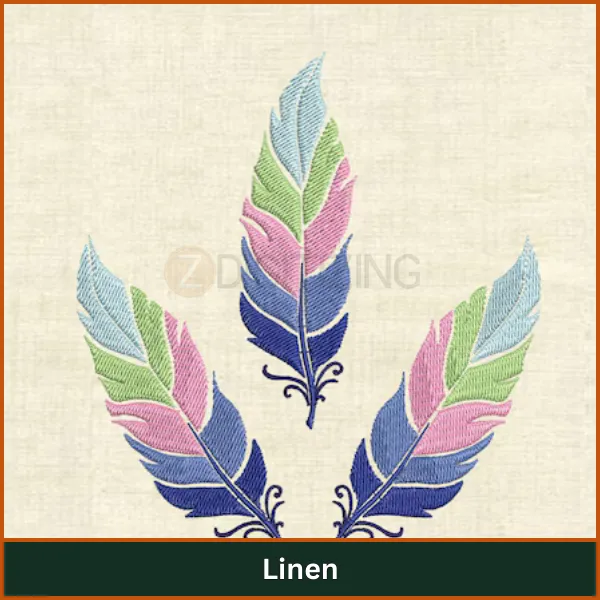
Linen is a natural, breathable fabric known for its classic texture and elegant appearance. It’s often chosen for decorative embroidery like monograms, name stitching, or vintage-inspired pieces. While it has a looser weave than cotton, it holds stitches well with proper stabilization.
Using a strong embroidery backing fabric is important to prevent shifting or puckering. Linen gives a timeless look to table runners, pillow covers, and wall art. It frays more easily, so edge finishing is important.
Though not as beginner-friendly as cotton, it’s perfect for those looking to create heirloom-quality projects.
Best for: Monograms, heirloom embroidery, decorative home décor.
Pricing: Linen is considered a mid-to-premium fabric. Expect to pay between $10 and $25 per yard, depending on the blend and weave tightness.
Pros and Cons
Pros | Cons |
|
|
3. Polyester
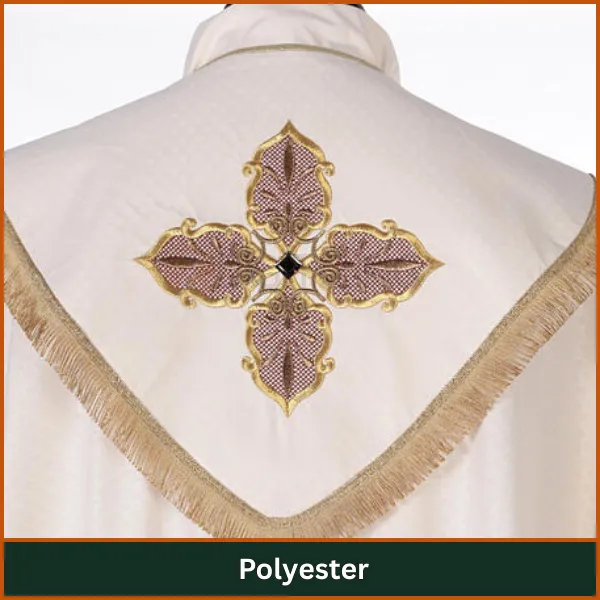
Polyester is a synthetic fabric often used in commercial blanks like polos, uniforms, and sportswear. It’s strong, colorfast, and resists shrinking, making it one of the best fabric for embroidery machine projects that involve repetition or production work.
Polyester doesn’t absorb moisture like cotton but works well with stabilizers such as no-show mesh or tear-away. It’s best suited for light to medium-density designs. Since polyester is heat-sensitive, always test your ironing temperature and avoid excessive pressing.
The fabric’s slippery surface may require more careful hooping, but it offers long-lasting results when stitched correctly.
Best for: Commercial embroidery, logos, uniforms, light branding designs.
Pricing: Polyester is budget-friendly, especially in blends. Prices generally range from $3 to $10 per yard, with higher-end performance fabrics costing a bit more.
Pros and Cons
Pros | Cons |
|
|
4. Denim
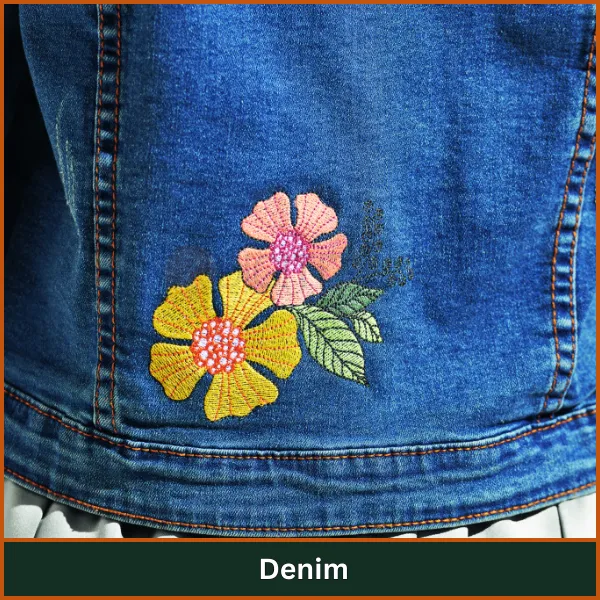
Denim is a thick, tightly woven cotton fabric that’s perfect for high-density embroidery. Commonly used for jackets, jeans, bags, and aprons, denim holds up well to bold designs and repeated washing.
If you’re wondering what fabric is used for embroidery when it comes to durable, long-lasting projects, denim is a top contender. Because it’s a heavy fabric, you’ll need a sturdy needle (90/14 or larger) and a strong cut-away embroidery stabilizer to keep your stitches clean. It provides an ideal surface for large or textured designs.
You may need to reduce your machine’s speed slightly for better control. Denim offers a rugged, stylish finish and is great for durable embroidery projects.
Best for: Dense embroidery, jacket logos, patches, heavy decorative designs.
Pricing: Denim is moderately priced, usually costing between $7 and $18 per yard, depending on weight and brand.
Pros and Cons
Pros | Cons |
|
|
5. Felt
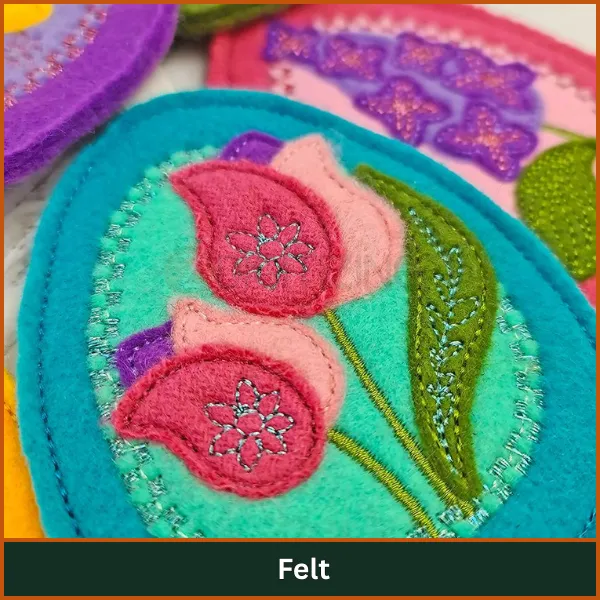
Felt is a soft, non-woven fabric made from natural or synthetic fibers. It’s one of the easiest fabrics to use for machine embroidery, especially for beginners. Since felt doesn’t fray, there’s no need for edge finishing, which makes it ideal for appliqué, patches, and small crafts.
It handles low-density designs well but isn’t suitable for complex or layered patterns. Use a light stabilizer if needed for better stitch quality. As one of the more accessible embroidery cloth types, felt is both affordable and fun to use in creative projects.
Best for: Applique, patches, badges, hobby crafts.
Pricing: Felt is very cost-effective, with most options ranging from $3 to $8 per yard, or even less for small craft sheets.
Pros and Cons
Pros | Cons |
|
|
6. Canvas
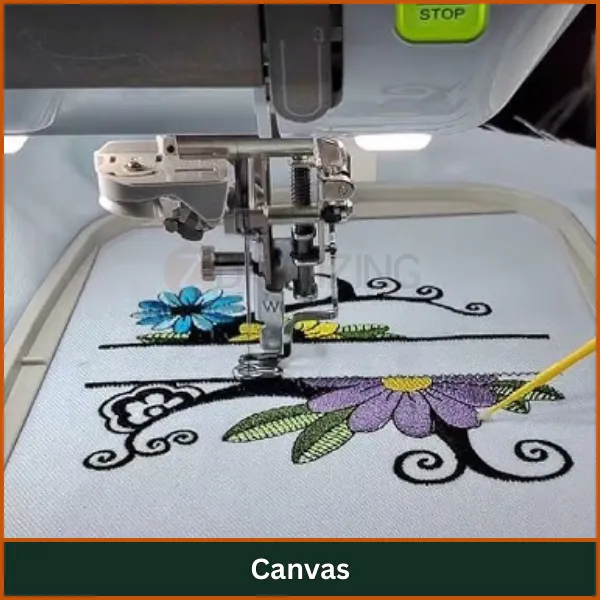
Canvas is a heavyweight, woven cotton fabric that provides strong support for embroidery. It’s perfect for tote bags, banners, pillows, and home décor. Due to its thickness, many embroiderers float canvas rather than hooping it directly.
A firm cut-away stabilizer is recommended for clean results. Canvas holds medium to large designs well, making it suitable for structured or bold embroidery. It offers a professional look and lasts through repeated use.
Best for: Home decor, tote bags, bold lettering, promotional embroidery.
Pricing: Canvas fabric typically costs between $6 and $15 per yard, depending on the weight and blend.
Pros and Cons
Pros | Cons |
|
|
7. Silk
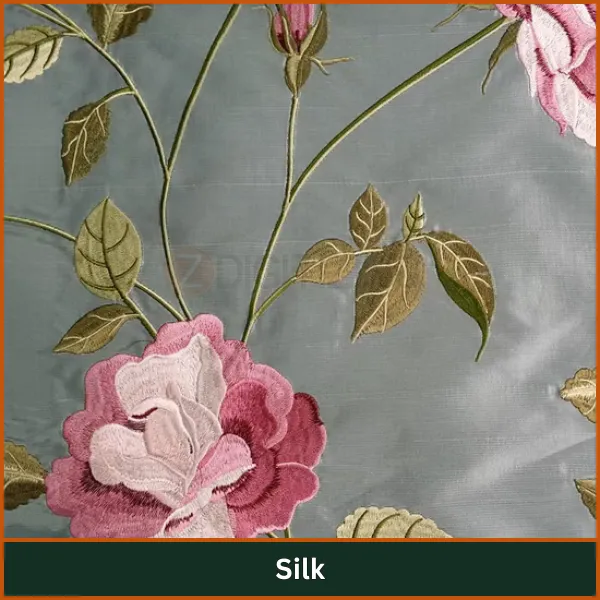
Silk is a lightweight, elegant fabric known for its softness and natural sheen. It’s often used for luxury embroidery projects, such as bridal accessories or framed artwork. While silk offers a beautiful finish, it requires extra care. The fabric is delicate and sensitive to hoop marks, so floating is recommended.
Always use a fine needle and pair it with a light embroidery backing, such as no-show mesh or wash-away stabilizer. Designs should be light and delicate, dense stitching may pucker or distort the fabric.
Best for: Light decorative embroidery, gifts, bridal pieces, framed work.
Pricing: Silk is considered a premium fabric and typically ranges from $15 to $40 per yard, depending on type and quality.
Pros and Cons
Pros | Cons |
|
|
How to Choose the Right Fabric for Your Embroidery Project?
When planning your design, knowing what fabric to use for embroidery is just as important as the thread or stabilizer you choose. The fabric acts as your foundation; if it’s too thin, too stretchy, or not compatible with your design, your results may suffer.
Picking the best fabric to embroider on ensures smooth stitching, less puckering, and a longer-lasting finish. Whether you’re working on apparel or home decor, understanding what fabric is best for embroidery will help you avoid common mistakes.
Here are key things to consider when choosing fabric for your embroidery project:
- Fabric weight: Light fabrics like silk are best for delicate designs, while heavy fabrics like denim or canvas can handle bold, dense stitching.
- Weave type: Tightly woven fabrics (like cotton or twill) are easier to embroider on than loose or stretchy ones.
- Stabilizer compatibility: Make sure your fabric works well with tear-away, cut-away, or wash away stabilizers depending on your design.
- Design complexity: Choose a fabric that can support the stitch density of your design without distorting.
- Hooping ability: Some fabrics (like felt or cotton) are easy to hoop, while others (like canvas or silk) may need to be floated.
- Project purpose: Consider where the item will be used; wearable items need flexible fabrics, while decorative pieces can use stiffer ones.
- Shrinkage and care: Pre wash fabrics like cotton and linen to avoid shrinking or warping after embroidery.
Fabric Challenges in Machine Embroidery
A lot of our customers and even viewers on our YouTube videos often ask about issues like puckering fabric, misaligned designs, or uneven stitching. These problems can ruin an otherwise perfect design, and we’ve seen beginners get discouraged because of them.
Many of them ask what is the best fabric to embroider on to avoid these frustrating issues from the start. But don’t worry, we’ve helped many people fix these problems with just a few simple changes.
1. Fabric Puckering After Stitching
This usually happens when the stabilizer isn’t strong enough or the fabric isn’t hooped tightly.
Solution: Use a cut-away stabilizer for stretchy or delicate fabrics and make sure your fabric is hooped tightly like a drum, not sagging.
2. Fabric Slipping Inside The Hoop
We’ve seen this a lot with satin, silk, and canvas.
Solution: Wrap the inner ring of your hoop with soft twill tape, or float the fabric and secure it with embroidery tape or temporary adhesive spray.
3. Design Shifting Or Not Aligning Properly
Often caused by unstable fabric or poor hooping technique.
Solution: Use a firm stabilizer, reduce machine speed, and avoid touching the hoop once stitching starts.
4. Fabric Tearing Or Needle Holes Showing
This usually happens with thin fabrics or when the wrong needle is used.
Solution: For delicate fabric, use a sharp needle (like size 70/10) and light stitch density. Always test your design on scrap fabric first.
5. Stretchy Fabrics Causing Distorted Designs
Common with T-shirts and jerseys.
Solution: Always use a cut-away stabilizer, hoop both fabric and stabilizer together, and avoid pulling the fabric while hooping.
So, next time you wonder what fabric do you use for embroidery, remember that success isn’t just about the fabric; it’s about prepping it properly and choosing the right stabilizer, hooping method, and needle for the job. These small changes can make a huge difference in your results.
Quick Comparison of the Best Fabric for Embroidery
If you’re unsure what fabric to use for embroidery, this comparison table will help you make the right choice based on your project needs. We’ve listed the most trusted fabrics for machine embroidery, including their weight, hooping ease, and stabilizer compatibility.
Fabric | Fabric Weight | Best For | Design Density | Stabilizer Type | Hooping Ease |
Cotton | Medium | Shirts, napkins, quilts | Light to Medium | Tear-away or cut-away | Easy |
Linen | Light-Medium | Monograms, home décor | Light to Medium | Cut-away | Moderate |
Polyester | Light-Medium | T-shirts, uniforms, sportswear | Light to Medium | No-show mesh or tear-away | Moderate |
Denim | Heavy | Jackets, jeans, tote bags | Medium to Heavy | Cut-away | Difficult |
Felt | Thick/Soft | Patches, appliqué, crafts | Light | Optional or tear-away | Very Easy |
Canvas | Heavy | Bags, signs, home décor | Medium to Heavy | Cut-away | Difficult (often floated) |
Silk | Light | Bridal, gifts, framed embroidery | Light | Wash-away or no-show mesh | Difficult (float recommended) |
Conclusion: Start with the Right Fabric, Avoid Headaches Later
Choosing the right fabric isn’t just a small detail, it’s the foundation of any successful machine embroidery project. From stabilizer compatibility to stitch quality, every step becomes easier and more professional when you start with the right material.
Now that you know what fabric to use for embroidery, you’re already one step ahead in avoiding common mistakes like puckering, shifting, or tearing.
At ZDigitizing, we understand that every fabric behaves differently, which is why we offer custom digitizing services tailored to your specific fabric type. Whether you’re working with cotton, canvas, silk, or polyester, our team ensures your design is digitized for optimal results, with guaranteed quality.
We also provide super-fast turnaround time and 24/7 customer support to help you meet any deadline, stress-free. Plus, first-time customers get 50% off their first order, so it’s the perfect time to try our services.
Need embroidery-ready designs that work perfectly on your chosen fabric? Contact us today or place your first order now and experience the difference ZDigitizing can make.
FAQs
For most embroidery projects, a medium weight fabric between 150-250 GSM (grams per square meter) works best. This weight provides the right balance, thick enough to hold your stitches firmly without stretching, yet thin enough for the needle to pass through easily. It’s ideal for both hand and machine embroidery.
The three main fabric types used in embroidery are woven fabrics (like cotton and linen), nonwoven fabrics (such as felt), and knit fabrics (like jersey). Woven fabrics are the most popular choice for both hand and machine embroidery because of their stability. Felt is great for patches and appliqué, while knits can be embroidered with the right stabilizer and technique.
Technically, you can embroider on almost any cloth that a needle can go through. However, woven, non-stretch fabrics like cotton, linen, or canvas are the easiest and most reliable options, especially for beginners. Stretchy or delicate fabrics need more experience and proper stabilizer support to get good results.
The fabric behind your main material is called embroidery backing or stabilizer. This layer provides support, prevents puckering, and keeps your design from distorting. Common types include tear-away for stable fabrics and cut-away for stretchy or delicate materials.
To choose the right fabric, look for one that’s medium-weight, has a tight weave, and is made from natural fibers like cotton or linen. Think about your project’s purpose—if it’s something you’ll wash often or wear regularly, durability and shrink-resistance matter. A good fabric ensures your design holds its shape and lasts longer.

